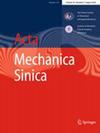Weak bearing fault diagnosis based on a time-delayed quad-stable stochastic resonance model
Abstract
This paper proposes a time-delayed quad-stable stochastic resonance (SR) model driven by Gaussian white correlated noises and a weak periodic signal. For the small time delay, the mean first-passage times and spectral amplification (SA) are derived. The curve of SA exhibits a typical resonant peak at an optimal noise intensity and SR happens. Moreover, as the time delay increases, the peak value of SA is enhanced for a fixed feedback gain. It is found that selecting appropriate cross-correlation between noises and feedback gain for fixed time delay can induce the appearance of SR. In particular, an ideal quad-stable potential structure is determined to optimize the SR effect. Subsequently, an adaptive improved quad-stable SR model based on quantum particle swarm optimization is proposed to determine the optimal structure parameters to maximize improved signal-to-noise ratio. Meanwhile, the proposed model is applied to diagnose weak bearing faults in inner race, outer race, and rolling elements. The results indicate that the time-delayed quad-stable SR model significantly enhances the fault diagnosis performance and resolves the issues related to side frequency interference compared to the underdamped bi-stable SR model and the underdamped quad-stable SR model. In the fault diagnosis of bearing rolling elements, the proposed SR model can accurately identify fault frequency values. While the underdamped bi-stable and quad-stable SR models are invalid for this case.

 求助内容:
求助内容: 应助结果提醒方式:
应助结果提醒方式:


